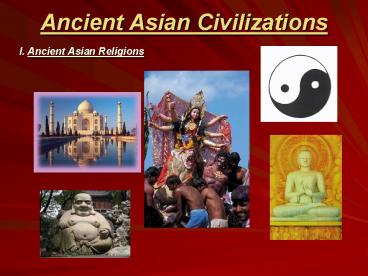Ancient Asian Civilizations - PowerPoint PPT Presentation
1 / 6
Title:
Ancient Asian Civilizations
Description:
– PowerPoint PPT presentation
Number of Views:169
Avg rating:3.0/5.0
Title: Ancient Asian Civilizations
1
Ancient Asian Civilizations
- I. Ancient Asian Religions
2
1. Hinduism
- a. Vedas
- -Holy books
- -Veda knowledge
- b. Upanishads
- -Philosophical Books
In Hindusim, this is the "great point" - the
perfect balance of all and the point from which
all of creation is projected and the point to
which all returns. The central point - the bindu
, is surrounded by a holon - a series of
concentric rings of repeated patterns,
representing the different layers of perception
and reality.
"The Vedic literatures are divided into two
parts the srutis and the smrtis. The srutis are
the four Vedas Rg, Sama, Atharva and Yajur, and
the Upanisads, and the smrtis are the Puranas
like the Mahabharata, which includes
Bhagavad-gita. The conclusion of all these is
that one should know Sri Krsna as the Supreme
Personality of Godhead."
3
"What is that by knowing which all things are
known?""What makes my mind think, my eyes see,
my tongue speak, my body live?"What happens when
this body dies?" With such questions begin the
Upanishads, the wellspring of India's loftiest
philosophies and faith. Some thousand years old,
they do not explain or develop a line of argument
in the modern sense. They are darshana,
"something seen", and the reader is expected not
only to listen to the words but to realize them
that is, to make their truths an integral part of
character, conduct, and consciousness. For the
last thousand years, ten Upanishads offered in
this book in modern English have been considered
as "principal Upanishads" on the authority of
Shankara, an eighth-century mystic who reawakened
India to its spiritual heritage. Included in the
book is the Shvetashvatara Upanishad for its
great beauty and four Yoga Upanishads to
represent later traditions.
4
1. Hinduism continued
- c. Religious Practice
- -Brahma
- -Creator
- -living soul
- -Karma
- -reincarnation
- -promotion or demotion
- through Caste System
- -based on personal conduct
- GOAL Union with Brahma
The caste system is like a religious social
standing system wich means that the population is
divided in higher and lower groups. The
expression "caste" comes from the portugese word
"casto" ("pure"). The four main castes (Brahmin,
Kshatriya, Vashaya and Shudra) are called
"Varnas", the Indian word for "colour". The
Varnas are split up in "Jati". The Jati are
subgroups of the castes, and depend on the
profession of the people. There is no social
mobility in the caste system, because people
mustnt marry people of other castes. Hinduism
believes in an eternal circle of rebirth which
ends in the "Nirvana", like our heaven or
paradise. That means a Hindu has many lives and
is reborn after death. The "Dharma" (Karma) is
his "account" of good and bad things he has done
in this life. The more bad things he has done in
this life the longer it will take to get to the
Nirvana. His Dharma decides in which caste he
will be born into in the next life. So the caste
system is justified.
5
2. Buddhism
- a. Siddhartha Gautama
- b. Buddha
- -Enlightened One
Siddharta Gautama is known as the Buddha. He was
born around the year 580 BCE in the village of
Lumbini in Nepal. He was born into a royal family
and for many years lived with in the palace walls
away from the sufferings of life sufferings such
as sickness, age, and death. He did not know what
they were. One day, after growing-up, marrying
and having a child, Siddhartha went outside the
royal palace and saw, each for the first time, an
old man, a sick man, and a corpse. He was worried
by what he saw. He learned that sickness, age,
and death were the inevitable fate of human
beings a fate no-one could avoid.
6
2. Buddhism continued
- c. Buddhist Practice
- -live a simple life
- -avoid earthly pleasures
- -practice good conduct
- GOAL
- Avoid Reincarnation
- enter Nirvana
- -Perfect Peace
- White transforms the delusion of ignorance into
the wisdom of reality- Yellow transforms pride
into wisdom of sameness- Blue transforms anger
into mirror like wisdom- Red transforms the
delusion of attachment into the wisdom of
discernment- Green transforms jealousy into the
wisdom of accomplishment































